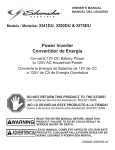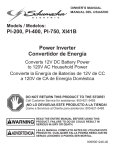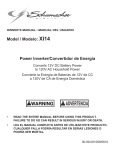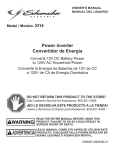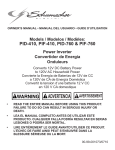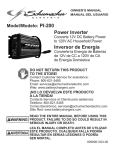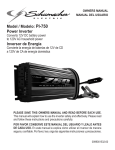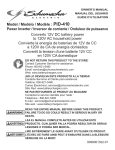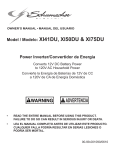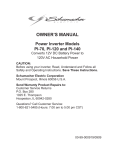Download Schumacher PI-1000 Owner`s manual
Transcript
OWNER’S MANUAL • Manual del usuario Power Inverter / Convertidor de Energía Models / Modelos: PI-1000 & PI-1500 Converts 12V DC Battery Power to 120V AC Household Power Convierte la Energía de Baterías de 12V de CD a 120V de CA de Energía Doméstica ADVERTENCIA • • READ THE ENTIRE MANUAL BEFORE USING THIS PRODUCT. FAILURE TO DO SO COULD RESULT IN SERIOUS INJURY OR DEATH. LEA EL MANUAL COMPLETO ANTES DE UTILIZAR ESTE PRODUCTO. CUALQUIER FALLA PODRÍA RESULTAR EN SERIAS LESIONES O PODRÍA SER MORTAL. 00-99-001142/00 DO NOT RETURN THIS PRODUCT TO THE STORE! Call Customer Service for Assistance: 800-621-5485 ¡NO LO DEVUELVA este producto A LA TIENDA! Llame a Servicios al Cliente para Asistencia: 800-621-5485 Table of Contents Section Page IMPORTANT SAFETY INSTRUCTIONS 1 INVERTER FEATURES 2 BEFORE USING YOUR POWER INVERTER 3 FASTENING THE INVERTER TO A FLAT SURFACE 3 CONNECTING INVERTER CABLES 3 USING THE GFCI OUTLET (MODEL PI-1500 ONLY) 5 OPERATING INSTRUCTIONS 5 POWER SOURCE 6 LED INDICATOR AND SHUTDOWN PROTECTION 6 IF THE INVERTER FUSE BLOWS 6 MAINTENANCE INSTRUCTIONS 7 Troubleshooting 7 BEFORE RETURNING FOR REPAIRS 7 SPECIFICATIONS 7 Limited warranty 8 ÍNDICE SECCIÓN PÀGINA INSTRUCCIONES IMPORTANTES DE SEGURIDAD 12 CARACTERÍSTICAS DEL CONVERTIDOR 13 ANTES DE USAR SU CONVERTIDOR DE ENERGÍA 14 PARA SUJETAR EL CONVERTIDOR A UNA SUPERFICIE PLANA 15 PARA CONECTAR LOS CABLES DEL CONVERTIDOR 15 PARA USAR LA TOMA DE CORRIENTE GFCI (SOLAMENTE MODELO PI-1500) 16 INSTRUCCIONES DE OPERACIÓN 17 FUENTE DE ENERGÍA 18 INDICADOR LED Y PROTECCIÓN DE DE APAGADO 18 SI SE QUEMA EL FUSIBLE DEL CONVERTIDOR 18 RESOLUCIÓN DE PROBLEMAS 19 ESPECIFICACIONES 19 IMPORTANT: READ AND SAVE THIS SAFETY AND INSTRUCTION MANUAL. SAVE THESE INSTRUCTIONS – The PI-1000 and PI-1500 offer a wide range of features to accommodate your needs. This manual will show you how to use your inverter safely and effectively. Please read, understand and follow these instructions and precautions carefully, as this manual contains important safety and operating instructions. The safety messages used throughout this manual contain a signal word, a message and an icon. The signal word indicates the level of the hazard in a situation. Indicates an imminently hazardous situation which, if not avoided, will result in death or serious injury to the operator or bystanders. Indicates a potentially hazardous situation which, if not avoided, could result in death or serious injury to the operator or bystanders. Indicates a potentially hazardous situation which, if not avoided, could result in moderate or minor injury to the operator or bystanders. Indicates a potentially hazardous situation which, if not avoided, could result in damage to the equipment or vehicle or property damage. Safety messages in this manual contain two different type styles. • Unnumbered type states the hazard. • Numbered type states how to avoid the hazard. The icon gives a graphical description of the potential hazard. Pursuant to California Proposition 65, this product contains chemicals known to the State of California to cause cancer and birth defects or other reproductive harm. 1. IMPORTANT SAFETY INSTRUCTIONS SAVE THESE INSTRUCTIONS RISK OF ELECTRIC SHOCK OR FIRE. 1.1 Keep out of reach of children. 1.2 Keep the inverter well ventilated in order to properly disperse heat generated while it is in use. Make sure there are several inches of clearance around the top and sides, and do not block the slots of the inverter. 1.3 Make sure the inverter is not close to any potential source of flammable fumes, gases or clothing. 1.4 Do not place the inverter in areas such as battery compartments or engine compartments where fumes or gases may accumulate. 1.5 Keep the inverter dry. 1.6 DO NOT allow the inverter to come into contact with rain or moisture. 1.7 DO NOT operate the inverter if you, the inverter, the device being operated or any other surfaces that may come into contact with any power source are wet. Water and many other liquids can conduct electricity, which may lead to serious injury or death. 1.8 Do not place the inverter on or near heating vents, radiators or other sources of heat or flammable materials. 1.9 Do not place the inverter in direct sunlight. The ideal air temperature for operation is between 50° and 80°F (10º and 27ºC). •1• 1.10 Only connect the power inverter to a 12 volt battery or power supply. Do not attempt to connect the inverter to any other power source, including an AC power source. Connecting to a 6 volt or 16 volt battery will cause damage to the inverter. 1.11 Make sure the AC plug is tight. 1.12 Do not modify the inverter in any way including cables, plugs, switches or AC receptacles as it may result in property damage or personal injury. 1.13 Incorrect operation of the inverter may result in property damage or personal injury. The inverter output is 120V AC and can shock or electrocute the same as any ordinary household AC wall outlet. 1.14 To reduce the risk of electric shock, disconnect the inverter from the power source before attempting any maintenance or cleaning. Simply turning off the controls will not reduce this risk. 1.15 Do not operate the inverter with damaged cables; have the cables replaced immediately by a qualified service person. (Call customer service at: 1-800-621-5485.) 1.16 Do not operate the inverter if it has received a sharp blow, been dropped or otherwise damaged in any way; take it to a qualified service person. (Call customer service at: 1-800-621-5485.) 1.17 Do not disassemble the inverter; take it to a qualified service person when service or repair is required. Incorrect reassembly may result in a risk of fire or electric shock. (Call customer service at: 1-800-621-5485.) 1.18 Working in the vicinity of a lead-acid battery is dangerous. Batteries generate explosive gases during normal battery operation. For this reason, it is of utmost importance that you follow the instructions each time you use the inverter. 1.19 This inverter employs parts, such as switches and circuit breakers, that tend to produce arcs and sparks. If used in a garage, locate this inverter 18 inches (46 cm) or more above the floor level. 1.20 Do not use the inverter with a product that draws a higher wattage than the inverter can provide, as this may cause damage to the inverter and product. 2. INVERTER FEATURES 1. ON/OFF Rocker Switch – Turns the inverter ON and OFF. 2. LED Indicator Light – (Green = power ON, Red = Overload/Interruption in power.) 3. 12-Volt Power Cord – One pair. 4. 120V AC Outlet – Two Standard (Model PI-1000) Two GFCI (Model PI-1500). 5. High-Speed Cooling Fan(s) – Keeps the inverter cool. The speed of the fan is faster as the load increases. The fan does not run when the inverter is turned OFF. 6. Analog Output Power Display – Shows 120V AC continuous power consumed. Five lights indicate half of the continuous output power and 10 lights indicate full continuous power consumption. When the inverter is OFF, the lights do not illuminate. 7. Positive Battery Cable Terminal (Red) – Accepts Positive connector cable. 8. Negative Battery Cable Terminal (Black) – Accepts Negative connector cable. 9. Ground Terminal – Grounds inverter to reduce electrical shock. 10.Thermal Protection – When the inverter case becomes hot (exceeds 145° F), the inverter shuts down until it cools off an then automatically restarts. 11. Surge Protection – When the power input from the vehicle’s battery exceeds 15 volts, the inverter shuts down. Once the voltage drops down to less than 14, it automatically restarts. 12.Low-Battery Protection – When the power input from the vehicle’s battery drops to approximately 10 volts, the inverter shuts down. •2• 3. BEFORE USING YOUR POWER INVERTER NOTE: Do not use the inverter with a product that draws a higher wattage than the inverter can provide, as this may cause damage to the inverter and product. When you turn on a device or a tool that runs on a motor, the device goes through two stages: 1. Start Up – Requiring an initial surge of power (commonly known as the “starting or peak load”). 2. Continuous Operation – Power consumption drops (commonly known as the “continuous load”). The wattage (WATTS) or amperes (AMPS) can normally be found stamped or printed on most devices and equipment, or in the user’s manual. Otherwise, contact the manufacturer to find out whether the device you want to use is compatible with a modified sine wave. To calculate the wattage: Wattage = AMPS x 120 (AC Voltage). To calculate the starting load: Starting Load = 2 x WATTS. In general, the start up load of the device or power tool determines whether or not your inverter has the capability to power it. To calculate the continuous load: Continuous Load = AMPS x 120 (AC Voltage). Always run a test to establish whether or not the inverter will operate a particular piece of equipment or device. In the event of a power overload, the inverter is designed to automatically shut down. This safety feature prevents damaging the inverter while testing devices and equipment within the wattage range of the inverter. If a device does not operate properly when first connected to the inverter, turn the inverter On/ Off switch ON, OFF, and ON again in quick succession. If this procedure is not successful, it is likely that the inverter does not have the required capacity to operate the device in question. This inverter uses a nonsinusoidal waveform. Therefore we do not recommend you use it to power the following devices: 1. Switch Mode Power Supplies; 2. Linear Power Supplies; 3. Class 2 Transformers; 4. Line Filter Capacitors; 5. Shaded Pole Motors; 6. Fan Motors; 7. Microwave Ovens; 8. Fluorescent and High Intensity Lamps (with a Ballast); and 9. Transformerless Battery Chargers. Doing so, may cause the device to run warmer or overheat. 4. FASTENING THE INVERTER TO A FLAT SURFACE For your convenience, the inverter can be fastened to a flat surface, horizontally or vertically. The area where the inverter is to be fastened must be dry, well ventilated and away from any combustible material or fumes. 1. Turn off and disconnect the inverter. 2. Place the back of the inverter with the mounting bracket against a flat, secure surface. 3. Attach the inverter to the flat surface using corrosion resistant screws. 5. CONNECTING INVERTER CABLES The inverter and power source must be in the OFF mode. Make sure to connect the inverter to a 12 volt power supply only. To avoid electrical shock, it is necessary to ground the inverter as well as the device powering it. The inverter should be grounded using a #8 AWG copper wire (not included). •3• NOTE: Do not turn on the inverter or the power source until the inverter and the power source are grounded. To ground the inverter: 1. Turn off and disconnect the inverter. 2. Locate the chassis ground screw below the negative terminal on the left side of the inverter. 3. Remove the outer hex nut and loosen the second hex nut. 4. Strip the insulation of the #8 AWG copper wire back 1.5” and wrap the bare end of the wire around the ground screw between the two washers. 5. While holding the wire in place, tighten the hex nut securely. Then, replace the other hex nut and tighten it securely. 6. Attach the other end of the wire to a properly grounded location: VEHICLE: Connect to the chassis, unpainted frame part, or engine block of the vehicle. BOAT: Connect to the boat grounding system. FIXED LOCATION: Connect to a ground rod or other appropriately rated ground. Inverter Connection: 1. Locate the Positive and Negative plastic terminals located on the left side of the inverter. Using a standard (flathead) screwdriver, unscrew the positive (red) and negative (black) terminal screws just enough to be able to insert the bare end of the connector cables. 2. Insert the bare end of the positive (red) cable into the positive (red) terminal. Insert the bare end of the negative (black) cable into the negative (black) terminal. Tighten each terminal screw so that the cable cannot come loose. Connecting Inverter Cable to 12V Battery or 12V Power Source: RISK OF CONTACT WITH BATTERY ACID. BATTERY ACID IS A HIGHLY CORROSIVE SULFURIC ACID. A SPARK NEAR THE BATTERY MAY CAUSE A BATTERY EXPLOSION. TO REDUCE THE RISK OF A SPARK NEAR THE BATTERY: 1. Keep hands, hair, clothing and jewelry clear of battery terminals. 2. Wear eye protection and clothing protection. 3. For a negative-grounded vehicle, connect the POSITIVE (RED) terminal from the inverter to the POSITIVE (POS, P, +) ungrounded post of the battery. Connect the NEGATIVE (BLACK) terminal to the vehicle chassis or engine block away from the battery. Do not connect the terminal to the carburetor, fuel lines or sheet-metal body parts. Connect to a heavy gauge metal part of the frame or engine block. 4. For a positive-grounded vehicle, connect the NEGATIVE (BLACK) terminal from the inverter to the NEGATIVE (NEG, N, -) ungrounded post of the battery. Connect the POSITIVE (RED) terminal to the vehicle chassis or engine block away from the battery. Do not connect the terminal to the carburetor, fuel lines or sheet-metal body parts. Connect to a heavy gauge metal part of the frame or engine block. 5. To disconnect the inverter, reverse the above steps. NOTE: The internal speaker may make a brief “beep” when the inverter is being connected to or disconnected from the 12 volt power source. Failure to make the correct connections will result in blown fuses and permanent damage to the inverter. •4• 6. USING THE GFCI OUTLET (MODEL PI-1500 ONLY) The PI-1500 inverter includes two GFCI (Ground Fault Circuit Interrupter) outlets located on the right side of the inverter. The purpose of a GFCI outlet is to quickly stop the flow of electricity in the event a ground fault occurs on the device plugged into the inverter’s GFCI outlet. Use only a 3-prong grounded plug when using the GFCI outlets. The GFCI outlets provide auxiliary power to 120V AC devices that require less than 15 amps; and auxiliary power to 120V AC devices that require less than 15 amp. If using both GFCI outlets at the same time, the amperage cannot exceed a total of 15 amps for both devices combined. The GFCI must be tested before each use. To test: 1. Connect the inverter (see CONNECTING INVERTER CABLES section). 2. Turn the inverter on. 3. Push the “Reset” button located on the GFCI receptacle first to assure normal GFCI operation. 4. Plug a night light (with an ON/OFF switch) or other device (such as a lamp) into the GFCI receptacle, and turn the device ON. 5. Push the “Test” button located on the GFCI receptacle. The night light (or other device) should turn OFF. 6. Push the “Reset” button and the light (or other device) should turn ON again. NOTE: If the light (or other device) remains ON when the “Test” button is pushed, the GFCI is not working properly and should not be used. Call Customer Service (1-800-621-5485). 7. OPERATING INSTRUCTIONS 1. Connect the inverter (see CONNECTING INVERTER CABLES section). 2. Switch the inverter On/Off switch to the ON (I) position. 3. The GREEN LED indicator light will light verifying the inverter is receiving power. 4. Switch the inverter On/Off switch to the OFF (O) position. (The GREEN LED power indicator light may flash briefly and/or the internal speaker may make a brief “beep”. This is normal.) 5. Make sure the device to be operated is turned OFF. 6. Plug the device into the inverter AC outlet. 7. Switch the inverter On/Off switch to the ON (I) position. 8. Turn the device on. 9. To disconnect, reverse the above procedure. NOTE: If more than one device is to be powered, start one device at a time to avoid a power surge and overloading the inverter. The surge load of each device should not exceed the inverter’s Continuous Operation wattage rate. If you are using the power inverter to operate a battery charger, monitor the temperature of the battery charger for about 10 minutes. If the battery charger becomes abnormally warm, disconnect it from the inverter immediately. NOTE: You can use an extension cord from the inverter to the device without significantly decreasing the power being generated by the inverter. Use an 18 gauge (AWG) (0.75mm2) extension cord. For best operating results, the extension cord should be no longer than 50 feet (15.2m). Using the Inverter to Operate a TV or Audio Device: The inverter is shielded and filtered to minimize signal interference. Despite this, some interference may occur with your television picture, especially with weak signals. Below are some suggestions to try and improve reception. 1. Make sure the television antenna produces a clear signal under normal operating conditions (i.e. at home plugged into a standard 120 volt AC wall outlet). Also, ensure that the antenna cable is adequately shielded and of good quality. •5• 2. Try altering the position of the inverter, antenna cables, and television power cord. Add an extension cord from the inverter to the TV so as to isolate its power cord and antenna cables from the 12 volt power source. 3. Try coiling the television power cord and the input cables running from the 12 volt power source to the inverter. 4. Affix one or several “Ferrite Data Line Filters” to the television power cord. Ferrite Data Line Filters can be purchased at most electronic supply stores. 5. Try grounding the inverter with a minimum 18 gauge (AWG) (0.75mm2) wire, using as short a length as possible. NOTE: You may hear a “buzzing” sound being emitted from inexpensive sound systems when operated with the inverter. This is due to ineffective filters in the sound system’s power supply. Unfortunately, this problem can only be resolved by purchasing a sound system with a higher quality power supply or higher quality filter. 8. POWER SOURCE When operating a device that draws approximately 60 watts, your average automobile or marine battery at full charge will provide an ample power supply to the inverter for approximately 3 hours when the engine is off. The actual length of time the inverter will function depends on the age and condition of the battery and the power demand being placed by the device being operated with the inverter. If you decide to use the inverter while the engine is off, we recommend you turn OFF the device plugged into the inverter before starting the engine. To maintain battery power, start the engine regularly and let it run for approximately 15 to 20 minutes to recharge the battery. Although it is not necessary to disconnect the inverter when turning over the engine, it may briefly cease to operate as the battery voltage decreases. While the inverter draws very low amperage when not in use, it should be unplugged to avoid battery drain. 9. LED INDICATOR AND SHUTDOWN PROTECTION The Green LED lights automatically when then inverter is plugged into a 12 volt DC power source and is turned on. The Red LED lights, the alarm sounds and the inverter automatically turns itself off under the following conditions: 1. When the power input from the vehicle’s battery drops to approximately 10.5 volts, low battery shutdown occurs and the inverter shuts off. Solution: Recharge or Replace the battery. 2. When the power input from the vehicle’s battery exceeds 15 volts, high voltage overload protection occurs. Solution: Reduce the voltage range to between 12 volts and 14 volts. 3. The continuous load demand from the equipment or device being operated exceeds the continuous load rating of the inverter being used. Solution: Use a higher capacity inverter or lower rated device. 4. The case temperature becomes hot (exceeds 145°F). Solution: Allow the inverter to cool. Do not block the cooling slots or air flow over and through the inverter. Reduce the load on the inverter to the continuous rated output. RESET: To reset after shutdown occurs, switch the inverter On/Off switch to the OFF (O) position. Check the source of the problem and correct. Switch the inverter On/Off switch to the ON (I) position. 10. IF THE INVERTER FUSE BLOWS The power inverter is fitted with fuses, which should not have to be replaced under normal operating conditions. A blown fuse is usually caused by reverse polarity or a short circuit within the device or equipment being operated. If the fuses blow: 1. The fuse is not user replaceable; take the inverter to a qualified service person. (Call customer service at: 1-800-621-5485.) •6• 11. MAINTENANCE INSTRUCTIONS 11.1 After use and before performing maintenance, unplug the device and disconnect the inverter from the 12 volt power supply. 11.2 Use a dry cloth to wipe all battery corrosion and other dirt or oil from the battery terminals, cords, and the inverter case. 11.3 Ensure that all of the inverter components are in place and in good working condition. 11.4 Servicing does not require opening the unit, as there are no user-serviceable parts. 11.5 All other servicing should be performed by qualified service personnel. 12. Troubleshooting PROBLEM REASON Red LED is on, audible alarm Poor contact at terminals. is on, and/or inverter does not function. Fuse blown. 13. SOLUTION Check connections at power supply. See “IF THE INVERTER FUSE BLOWS” section. Inverter shutdown. See “LED INDICATOR AND SHUTDOWN PROTECTION” section. Inverter may not be working properly. See Warranty and call Customer Service 1-800-6215485 (Hours: 7 am – 5 pm CST). BEFORE RETURNING FOR REPAIRS 13.1 When an inverter problem arises, make certain that the power supply is operating properly (fully charged). Double check all connections for correct polarity and the quality of the connections from the cables to the connectors and from the connectors to the inverter. The connectors must be clean. 13.2 When an UNKNOWN OPERATING PROBLEM arises, please read the complete manual and call the customer service number for information that will usually eliminate the need for return. If the above solutions do not eliminate the problem or for information about troubleshooting, call toll-free from anywhere in the U.S.A. 1-800-621-5485 7:00 am to 5:00 pm Central Time Monday through Friday 14. SPECIFICATIONS Model: PI-1000 Maximum Continuous Power 1000 Watts Surge Capability (Peak Power) 2000 Watts No Load Current Draw <0.6A Wave Form Modified Sine Wave Input Voltage Range 10.5V – 15.5V DC Output Voltage Range 110V – 125V AC Low Battery Alarm Audible, 10.3V – 10.6V DC Low Battery Shutdown 9.7V – 10.3V DC High Battery Shutdown 15.0V – 16.0V DC Optimum Efficiency >85% •7• Model: PI-1000 AC Outlet Two, 120V AC NEMA 5-15 Dimensions 10.5” L x 9” W x 3.75” H (267 x 229 x 95.2 mm) Weight Approximately 7.25 lbs. (3288.5 g) Model: PI-1500 Maximum Continuous Power 1500 Watts Surge Capability (Peak Power) 3000 Watts No Load Current Draw <0.6A Wave Form Modified Sine Wave Input Voltage Range 10.5V – 15.5V DC Output Voltage Range 110V – 125V AC Low Battery Alarm Audible, 10.3V – 10.6V DC Low Battery Shutdown 9.7V – 10.3V DC High Battery Shutdown 15.0V – 16.0V DC Optimum Efficiency >85% AC Outlet Two, 120V AC 3-Prong GFCI Dimensions 11” L x 9.5” W x 3.75” H (279 x 241 x 95.2 mm) Weight Approximately 7.9 lbs. (3583.4 g) 15. Limited warranty SCHUMACHER ELECTRIC CORPORATION, 801 BUSINESS CENTER DRIVE, MOUNT PROSPECT, IL 60056-2179, MAKES THIS LIMITED WARRANTY TO THE ORIGINAL RETAIL PURCHASER OF THIS PRODUCT. THIS LIMITED WARRANTY IS NOT TRANSFERABLE OR ASSIGNABLE. Schumacher Electric Corporation (the “Manufacturer”) warrants this inverter for 2 years from the date of purchase at retail against defective material or workmanship that may occur under normal use and care. If your unit is not free from defective material or workmanship, Manufacturer’s obligation under this warranty is solely to repair or replace your product with a new or reconditioned unit at the option of the Manufacturer. It is the obligation of the purchaser to forward the unit, along with mailing charges prepaid to the Manufacturer or its authorized representatives in order for repair or replacement to occur. Manufacturer does not provide any warranty for any accessories used with this product that are not manufactured by Schumacher Electric Corporation and approved for use with this product. This Limited Warranty is void if the product is misused, subjected to careless handling, repaired, or modified by anyone other than Manufacturer or if this unit is resold through an unauthorized retailer. Manufacturer makes no other warranties, including, but not limited to, express, implied or statutory warranties, including without limitation, any implied warranty of merchantability or implied warranty of fitness for a particular purpose. Further, Manufacturer shall not be liable for any incidental, special or consequential damage claims incurred by purchasers, users or others associated with this product, including, but not limited to, lost profits, revenues, anticipated sales, business opportunities, goodwill, business interruption and any other injury or damage. Any and all such warranties, other than the limited warranty included herein, are hereby expressly disclaimed and excluded. Some states do not allow the exclusion or limitation of incidental or consequential damages or length of implied warranty, so the above limitations or exclusions may not apply to you. This warranty gives you specific legal rights and it is possible you may have other rights which vary from this warranty. •8• THIS LIMITED WARRANTY IS THE ONLY EXPRESS LIMITED WARRANTY AND THE MANUFACTURER NEITHER ASSUMES OR AUTHORIZES ANYONE TO ASSUME OR MAKE ANY OTHER OBLIGATION TOWARDS THE PRODUCT OTHER THAN THIS WARRANTY. Schumacher Electric Corporation Customer Service 1-800-621-5485 Monday – Friday 7:00 a.m. to 5:00 p.m. CST Schumacher and the Schumacher Logo are registered trademarks of Schumacher Electric Corporation To activate the warranty, please fill in the warranty registration card on page 10 and mail it in, OR go to www.batterychargers.com to register your product online. DO NOT RETURN THIS PRODUCT TO THE STORE! Call Customer Service for Assistance: 800-621-5485 •9• 2 YEAR LIMITED WARRANTY PROGRAM REGISTRATION MODEL:___________________ DESCRIPTION:___________________________ This is the only express limited warranty, and the manufacturer neither assumes nor authorizes anyone to assume or make any other obligation. There is no other warranty, other than what is described in the product owner’s manual. The warranty card should be submitted within 30 days of purchase. The customer must keep the ORIGINAL receipt because it will be required for any warranty claims. This warranty is not transferable. Mail To: Schumacher Electric Corporation 801 Business Center Drive Mount Prospect, IL 60056-2179 Name_______________________________________________________________ Street Address________________________________________________________ City_________________________________State__________Zip Code__________ Phone______________________Email____________________________________ Store Name Where Purchased____________________Date of Purchase__________ Store Location_____________________UPC Number_________________________ Serial Number________________________(SEE PRODUCT) PROGRAMA DE REGISTRO DE 2-AÑOS DE GARANTÍA LIMITADA MODELO:___________________ DESCRIPCIÓN:___________________________ Esta es la única garantía limitada expresa, y el productor no autoriza ni otorga a alguien a realizar alguna otra obligación. No existe ninguna otra garantía más que la descrita en el manual del dueño. La tarjeta de garantía debe enviarse durante los primeros 30 días después de la compra. El cliente debe mantener el recibo de compra ORIGINAL como comprobante, el cual le otorga todo derecho a cualquier reclamo de garantía. Esta garantía no es tranferible. Mail To: Schumacher Electric Corporation 801 Business Center Drive Mount Prospect, IL 60056-2179 Nombre______________________________________________________________ Dirección_____________________________________________________________ Ciudad_______________________________Estado_____________C.P.__________ Tel:_______________________Correo electrónico____________________________ Nombre de la Tienda donde se Compró_________________Fecha de compra _____ Localización de la Tienda___________________Numero de Serie _______________ Código de barras ________________________(CONSULTE EL PRODUCTO) • 10 • • 11 • IMPORTANTE: LEA Y GUARDE ESTE MANUAL DE INSTRUCCIONES Y SEGURIDAD. GUARDE ESTAS INSTRUCCIONES: Los PI-1000 y PI-1500 ofrecen una amplia gama de características para satisfacer sus necesidades. Este manual le mostrará cómo utilizar su convertidor en forma segura y efectiva. Por favor, lea, comprenda y siga estas instrucciones y precauciones cuidadosamente, ya que este manual contiene instrucciones operativas y de seguridad de importancia. Los mensajes de seguridad representados en este manual contienen palabras guía, un mensaje y una figura. La palabra guía indica el nivel de peligro en determinada situación. una inminente situación de riesgo que, si no se evita, resultaría mortal o PELIGRO Indica de serios perjuicios al operador o personas alrededor. ADVERTENCIA Indica una situación potencialmente riesgoso que, si no se evita, podría resultar o de serios perjuicios al operador o personas alrededor. ATENCIÓN Indica una situación potencialmente peligrosa que, de no evitarse, podría resultar en menores o serio daños al usuario y terceras personas. IMPORTANTE Indica una situación potencialmente peligrosa que, de no evitarse, podría causar daño al equipo, al vehículo y propiedades alrededor. Los mensajes estipulados en este manual se describen dos tipos de estilo. • Los que aparecen sin número indican el riesgo. • Aquellos que aparecen numerados, indican cómo evitar los riesgos. La figura muestra una descripción gráfica del potencial de riesgo. ADVERTENCIA Conforme a la propuesta 65 de California, este producto contiene químicos de los cuales en el Estado de California se tiene conocimiento que provocan cáncer y malformaciones congénitas u otras lesiones reproductivas. 1. INSTRUCCIONES IMPORTANTES DE SEGURIDAD GUARDE ESTAS INSTRUCCIONES El riesgo de descarga eléctrica o incendio. 1.1 Manténgase alejado de los niños. 1.2 Mantenga el convertidor bien ventilado para dispersar apropiadamente el calor generado cuando está en uso. Asegúrese de que haya varias pulgadas de libramiento alrededor de la parte superior y lados y no bloquee las ranuras del convertidor. 1.3 Asegúrese de que el convertidor no esté cerca de ninguna fuente potencial de gases inflamables, gases o ropa. 1.4 No coloque el convertidor en áreas tales como compartimientos de baterías o compartimientos del motor donde los vapores o gases pueden acumularse. 1.5 Mantenga el convertidor seco. 1.6 NO OPERE el convertidor si usted, el convertidor, el dispositivo a ser operado o cualquier otra superficie puede entrar en contacto con cualquier fuente de energía que está húmeda. El agua y muchos otros líquidos pueden conducir electricidad, lo cual puede llevar a una lesión seria o la muerte. 1.7 NO OPERE el convertidor si usted, el convertidor, el dispositivo a ser operado o cualquier otra superficie que puede entrar en contacto con cualquier fuente de energía está húmeda. El agua y muchos otros líquidos pueden conducir electricidad, lo cual puede llevar a una lesión seria o la muerte. 1.8 No coloque el convertidor sobre o cerca de ventilas de calefacción, radiadores u otras fuertes de calor o materiales inflamables. • 12 • 1.9 No coloque el convertidor en la luz directa del sol. La temperatura del aire ideal para la operación es entre 50° y 80°F. 1.10 Solamente conecte el convertidor de energía a una toma de corriente accesoria de 12V o a una toma de energía de 12V en un avión. No intente conectar el convertidor a cualquier otra fuente de energía, incluyendo una fuente de energía de CA (corriente alterna). El conectarlo a una batería de 6 V o 16 V dañará el convertidor. 1.11 Asegúrese de que la clavija de CA estén ajustadas. 1.12 No modifique el inversor de ninguna forma, incluyendo los cables, enchufes, interruptores o receptors de CA, esto podría causar serios daños personales o materiales. 1.13 La operación incorrecta de su convertidor puede resultar en daño y lesión personal. ADVERTENCIA La salida del convertidor es de 120 V CA y puede dar una descarga o electrocutar igual que cualquier toma de corriente de pared doméstica de CA ordinaria. 1.14 Para reducir el riesgo de descarga eléctrica, desenchufe del convertidor de energía antes de intentar llevar a cabo cualquier actividad de mantenimiento o limpieza. El simple apagado de los controles no reducirá este riesgo. 1.15 No utilice el convertidor si el mismo posee unos cables dañado; substituya los cables inmediatamente por una persona calificada en el ramo. (Comuníquese con el servicio al cliente al: 1-800-621-5485.) 1.16 No utilice el convertidor si el mismo recibió un golpe fuerte, si se cayó o si sufrió daños de cualquier otra forma; hágalo revisar por una persona capacitada que efectúe reparaciones. (Comuníquese con el servicio al cliente al: 1-800-621-5485.) 1.17 No desarme el convertidor; hágalo revisar por una persona capacitada que efectúe reparaciones cuando necesite servicio de mantenimiento o una reparación. Volver a ensamblar el convertidor en forma incorrecta puede provocar riesgo de incendio o descarga eléctrica. (Comuníquese con el servicio al cliente al: 1-800-621-5485.) 1.18 Resulta peligroso trabajar en forma cercana a una batería de plomo. Las baterías generan gases explosivos durante su normal funcionamiento. por este motivo, resulta de suma importancia que siga las instrucciones cada vez que utiliza el convertidor. 1.19 Este convertidor está equipado con partes, tales como, interruptores y cortacircuitos, que tienden a originar chispas y cortos. Si se utiliza en la cochera, utilice el convertidor 18 pulgadas (46) o más del nivel del suelo. 1.20 No utilice el convertidor con un producto que absorba mayor cantidad de watts que el convertidor pueda proveer, esto podría causar daño al convertidor y al producto. 2. CARACTERÍSTICAS DEL CONVERTIDOR 1. Interruptor de Balancín de ENCENDIDO/APAGADO (ON/OFF) - Enciende y apaga el convertidor. 2. Luz Indicadora LED - (Verde = energía ENCENDIDA, Roja = Sobrecarga, interrupción en la energía. 3. Cable de Energía de 12 V - Un par 4. Toma de Corriente de 120 V CA - Dos Estándar (Modelo de PI-1000) Dos Interruptores de Circuito con Conexión a Tierra (GFCI por sus siglas en inglés) (Modelo PI-1500) 5. Abanico(s) de Enfriamiento de Alta Velocidad - Mantiene el convertidor fresco. La velocidad del abanico es más rápida al incrementarse la carga. El abanico no funciona cuando él convertidor está APAGADO. 6. Visualizador Análogo de Salida de Energía - muestra la energía de 120V de CA continua consumida. Cinco luces indican la mitad de la energía continua de salida y diez luces indican el consumo de la total energía continua. Cuando el convertidor está APAGADO, no parece ninguna luz. 7. Terminal Positiva del Cable de la Batería (Roja) - Acepta un cable conector Positivo. 8. Terminal Negativa del Cable de la Batería (Negra) - Acepta un cable conector Negativo. 9. Termina la Tierra - Conecta a tierra el convertidor para reducir la descarga eléctrica. • 13 • 10.Protección Térmica - Cuando la caja del convertidor se calienta (excede los 145 °F) el convertidor se apaga. 11. Protección contra Sobretensión - Cuando la entrada de energía de la batería del vehículo excede 15 V el convertidor se apaga. 12.Protección contra Batería Baja - Cuando la entrada de energía de la batería del vehículo baja a aproximadamente 10 V el convertidor se apaga. 3. ANTES DE USAR SU CONVERTIDOR DE ENERGÍA NOTA: No utilice el inversor con un producto que absorba mayor cantidad de watts que el inversor pueda proveer, esto podría causar daño al inversor y al producto. Cuando usted enciende un dispositivo o una herramienta que funciona con un motor, el dispositivo básicamente pasa a través de dos etapas: 1. Arranque - Requiriendo una subida inicial de voltaje (comúnmente conocida como “carga de inicio o pico”). 2. Operación Continua - el consumo de energía desciende (comúnmente conocido como la “carga continua”). El vataje (WATTS) o amperaje (AMPS) pueden ser encontrados normalmente estampados o impresos en la mayoría de los dispositivos y equipo, o en el manual del usuario. Por lo demás, comuníquese con el fabricante para averiguar si el dispositivo que usted quiere usar es compatible con una onda senoidal modificada. Para calcular el vataje: Vataje = AMPS x 120 (Voltaje CA). Para calcular la carga de arranque: Carga de Arranque = 2 x WATTS. En general, la carga de arranque del dispositivo o herramienta eléctrica determina si su convertidor tiene la capacidad de hacerlo funcionar. Para calcular la carga continua: Carga Continua = AMPS x 120 (Voltaje CA). IMPORTANTE Siempre corra una prueba para establecer si el convertidor operará una pieza particular de equipo o dispositivo. En caso de una sobrecarga de corriente, el convertidor está diseñado para apagarse automáticamente. Ésa característica de seguridad evitar dañar el convertidor mientras se prueban dispositivos y equipo dentro del ámbito de vataje del convertidor. Si un dispositivo no funciona apropiadamente cuando se conecta por primera vez al convertidor, de vuelta al interruptor broker a ENCENDIDO (ON) (I), APAGADO (OFF) (O) y nuevamente ENCENDIDO (ON) (I) en rápida sucesión. Si este procedimiento no tiene éxito, es probable que el convertidor no tenga la capacidad requerida para operar el dispositivo en cuestión. IMPORTANTE Este inversor está diseñado para operar aparatos de 100 watts o menos usado el Puerto de 12 voltios. Para utilizar la salida completa, usted debe usar el adaptador de las pinzas de la batería y así conectar el inversor directamente a la batería. NOTA: El límite de 100 watts es para adaptar la proporción del fusible a todos los vehículos. Algunos vehículos pueden permitir la salida. Si el fusible se funde cuando cambie al aparato que intenta usar, solo tiene dos opciones: Usar un aparato más pequeño o conectar el inversor directamente a la batería. IMPORTANTE Este inversor usa ondas solenoids. Por lo tanto, no recomendamos para operar los siguientes aparatos: 1. Fuentes energía de en forma de conmutador. 2. Líneas de corriente eléctrica 3. Transformadores clase2 4. Condensadores de capacidad 5. Motores ligeros. 6. Motores de ventilador 7. Hornos de microondas 8. Lámparas flourescentes y de alta intensidad (con balastra); y • 14 • 9. Cargadores de Baterías sin tranformador. Al hacerlo, podría operar el aparato bajo intenso calor y sobrecalentarlo. 4. PARA SUJETAR EL CONVERTIDOR A UNA SUPERFICIE PLANA Por comodidad su convertidor puede ser sujetado a una superficie plana, horizontal o verticalmente. El área donde el convertidor será sujetado debe ser seca, bien ventilada y estar alejada de cualquier material o gases combustibles. 1. Apague y desconecte el convertidor. 2. Coloque la parte posterior del convertidor con el soporte de montaje contra una superficie segura y plana. 3. Sujete el convertidor a la superficie plana usando tornillos resistentes a la corrosión 5. PARA CONECTAR LOS CABLES DEL CONVERTIDOR El convertidor y la fuente de energía deben estar en el modo APAGADO (OFF). IMPORTANTE Asegúrese de conectar su convertidor a una fuente de energía de 12V solamente. Para evitar descarga eléctrica, es necesario conectar a tierra el convertidor así como el dispositivo que le da energía. El convertidor debe ser conectado a tierra usando un alambre de cobre calibre #8 AWG (no incluido). NOTA: No encienda el convertidor o la fuente de energía hasta que el convertidor y la fuente de energía estén conectados a tierra. Para conectar a tierra el convertidor: 1. Apague y desconecte el convertidor. 2. Ubique el tornillo a tierra del chasís abajo de la terminal negativa sobre el lado izquierdo del convertidor. 3. Quite la tuerca hexagonal externa y afloje la segunda tuerca hexagonal. 4. Quite el aislamiento a 1.5” del cable del cobre calibre #8 (AWG) y envuelva el apunta a fin aislamiento del alambre alrededor del tornillo de conexión a tierra entre las dos arandelas. 5. A mientras sostiene el alambre en que su lugar, apriete la tuerca hexagonal que aflojó hasta que esté segura. Luego, reemplace la otra tuerca hexagonal y apriétela hasta que esté segura. 6. Sujete la otra punta del alambre a una ubicación conectada a tierra de forma apropiada: VEHÍCULO: Conecte al chasís, parte sin pintar del bastidor, o bloque del motor del vehículo. BARCO: Conecte al sistema de conexión a tierra del barco. UBICACIÓN FIJA: Conectar con una varilla a tierra u otra conexión a tierra apropiadamente clasificada. Conexión Del Convertidor: 1. Ubique las terminales plásticas Positiva y Negativa ubicadas en la parte izquierda del convertidor. Usando un desarmador estándar (plano), desatornille los tornillos positivo (rojo) y negativo (negro) de las terminales lo suficiente para poder insertar la parte sin aislamiento de los cables conectores. 2. Inserte la parte sin aislamiento del cable positivo (rojo) en la terminal positiva (roja). Inserte la parte sin aislamiento del cable negativo (negro) en la terminal negativa (negra). Apriete el tornillo de cada terminal para que el cable no pueda soltarse. Para Conectar Los Cables Del Convertidor A Una Batería De 12v O Una Fuente De Energía De 12v: Riesgo de contacto con el ácido de la batería. El ácido de la batería es un ácido sulfúrico altamente corrosivo. • 15 • UNA CHISPA PROVOCADA CERCA DE LA BATERÍA PUEDE CAUSAR LA EXPLOSIÓN DE LA BATERÍA. PARA REDUCIR EL RIESGO DE PROVOCAR CHISPAS CERCA DE LA BATERÍA: 1. Mantenga las manos, cabello, ropa y joyería alejados de las terminales de la batería. 2. Usé protección para ojos y protección para la ropa. 3. En un vehículo con descarga a tierra por borne negativo, conecte el gancho POSITIVO (ROJO) del convertidor de batería al borne POSITIVO (POS, P, +) sin descarga a tierra de la batería. Conecte el gancho NEGATIVO (NEGRO) al chasis del vehículo o al bloque motor alejado de la batería. No conecte el gancho al carburador, líneas de combustible o cuerpos metálicos. Conecte a una pieza metálica de calibre grueso del marco o del bloque motor. 4. En un vehículo con descarga a tierra por borne positivo, conecte el gancho NEGATIVO (NEGRO) del convertidor de batería al borne NEGATIVO (NEG, N, -) sin descarga a tierra de la batería. Conecte el gancho POSITIVO (ROJO) al chasis del vehículo o al bloque motor alejado de la batería. No conecte al carburador, líneas de combustible o cuerpos metálicos. Conecte a una pieza metálica de calibre grueso del marco o del bloque motor. 5. Para desconectar el convertidor, invierta los pasos anteriores. NOTA: La bocina interna puede hacer breve “bip” cuando el convertidor está siendo conectado a o desconectado de la fuente de energía de 12V. IMPORTANTE El no hacer las conexiones correctas resultará en fusibles quemados y daño permanente el convertidor. 6. PARA USAR LA TOMA DE CORRIENTE GFCI (SOLAMENTE MODELO PI-1500) El convertidor PI-1500 incluye dos tomas de corriente “GFCI” (de Interruptor de Circuito con Conexión a Tierra) ubicadas en la parte derecha del convertidor. El propósito de una toma de corriente GFCI es detener rápidamente el flujo de electricidad en el caso de que ocurra una falla a tierra en el dispositivo conectado a la toma del corriente GFCI del convertidor. Use solamente clavijas con conexión a tierra de 3 patas conduce la toma de corriente GFCI. Las tomas de corriente GFCI proporcionan energía a auxiliar a dispositivos de 120 V de CA que requieren menos de 15 amps. Las tomas de corriente GFCI proporcionan energía a auxiliar a dispositivos de 120 V de CA que requieran menos de 15 amps. Si usa ambas tomas de corriente GFCI al mismo tiempo, el amp era que no puede exceder un total de 15 amps para ambos dispositivos combinados. El GFCI (Interruptor de Circuito con Conexión a Tierra) debe aprobarse antes de cada uso. Para probar: 1. Conecte el convertidor (ver la sección “PARA CONECTAR LOS CABLES DEL CONVERTIDOR”). 2. Encienda el dispositivo. 3. Oprima el botón “Reset” (Restablecer) en el receptáculo GFCI, primero para asegurar la operación normal del GFCI. 4. Conecte una luz nocturna (con un interruptor de APAGADO/ENCENDIDO (ON/OFF)) en el receptáculo GFCI y encienda el dispositivo (ON). 5. Oprima el botón “Test” (Probar) ubicado en el receptáculo GFCI. La luz nocturna u otro dispositivo deben “APAGARSE” (OFF). 6. Oprima el botón (Restablecer) y la luz otro dispositivo deben “ENCENDERSE” (ON) de nuevo. NOTA: Si la luz otro dispositivo permanecen ENCENDIDOS (ON) cuando se oprime el botón “Test” (Probar), el GFCI no está funcionando apropiadamente y no debe ser usado. Llame al Servicio al Cliente (1-800-621-5485). • 16 • 7. INSTRUCCIONES DE OPERACIÓN 1. Conecte el convertidor (ver la sección “PARA CONECTAR LOS CABLES DEL CONVERTIDOR”). 2. Cambie el interruptor del convertidor a la posición de ENCENDIDO (ON) (I). 3. La luz del indicador LED debe brillar VERDE verificando que el convertidor está recibiendo energía. 4. Cambie el interruptor de balancín del convertidor a la posición de APAGADO (OFF) (O). (El indicador de energía LED VERDE puede parpadear brevemente y/o la bocina interna puede hacer un breve “bip”. Esto es normal.). 5. Asegúrese de que el dispositivo a ser operado este APAGADO (OFF). 6. Conecte el dispositivo en la toma de corriente CA del convertidor. 7. Encienda el dispositivo. 8. Enciende el dispositivo. 9. Para desconectar, invierta el procedimiento anterior. NOTA: Si se va a dar energía a más de un dispositivo, inicie un dispositivo a la vez para evitar una sobretensión de energía y sobrecargar el convertidor. La sobretensión de cada dispositivo no debe exceder el ámbito de vataje de Operación Continúa el convertidor. IMPORTANTE Si usted usando el convertidor de energía para operar un cargador de baterías, monitoree la temperatura del cargador de baterías por aproximadamente 10 minutos. Si el cargado de graderías se pone anormalmente caliente, desconéctelo del convertidor inmediatamente. NOTA: Se puede utilizar una extensión del Inversor al aparato sin causar significante pérdida de poder generado por el inversor. Se recomienda una extensión de calibre 16 (AWG) de (1.5mm2) Para obtener mejores resultados, la extensión no debe sobrepasar 50 pies (15 metros). Para Usar El Convertidor Para Operar Una Televisión O Dispositivo De Sonido: El convertidor está protegido y filtrado para minimizar la interferencia con la señal. A pesar de esto, alguna interferencia puede ocurrir con la imagen de su televisión, especialmente con señales débiles. Abajo y algunas sugerencias para tratar y mejorar la recepción. 1. Asegúrese de que la antena de televisión produzca una señal clara bajo condiciones normales de operación (Ej. en casa conectado en una toma de corriente de pared estándar de 120 V de CA). También, asegúrese de que el cable de la antena este protegido adecuadamente y que sea de buena calidad. 2. Trate de alterar la posición del convertidor, los cables de la antena y el cable de corriente de la televisión. Agregue un cable de extensión del convertidor a la televisión para aislar el cable de energía y los cables de la antena de la fuente de energía de 12V. 3. ntente enrollar el cable de energía de la televisión y los cables de aporte que van de la fuente de energía de 12V al convertidor. 4. Fije uno o varios “Filtros de Línea de Datos de Ferrita” al cable de energía de la televisión. Los Filtros de Línea de Datos de Ferrita pueden comprarse la mayor parte de las tiendas de partes electrónicas. 5. Intente conectar a tierra el convertidor con un alambre de 18 AWG (medida de cable americana) (mínimo) (0.75mm2), usando un tramo tan corto como sea posible. NOTA: Usted puede escuchar un sonido de “zumbido” siendo emitido de sistemas de sonido baratos cuando son operados con el convertidor. Esto es debido a filtros inefectivos en el abastecimiento de energía del sistema de sonido. Lamentablemente, este problema solamente puede ser resuelto comprando un sistema de sonido con una calidad más alta de abastecimiento de sonido o un filtro de más alta calidad. • 17 • 8. FUENTE DE ENERGÍA Cuando se opere un aparato que absorve aproximadamente 60 watts, su batería de automóvil o marina promedio a toda carga proporcionará un abastecimiento de energía amplio para él convertidor por aproximadamente dos a tres horas cuando el motor está apagado. El tiempo total que el convertidor funcionará depende de la edad y condición de la batería y de la demanda de energía colocada por el dispositivo siendo operado con el convertidor. Si decide usar el convertidor mientras el motor está apagado, le recomendamos que apague el dispositivo conectado al convertidor antes de arrancar el motor. Para mantener la energía de la batería, arranque el motor cada hora o dos y déjelo encendido por aproximadamente 30 minutos para recargar la batería. Aunque no es necesario desconectar el convertidor cuando arranca de nuevo el motor, puede dejar de operar brevemente mientras disminuye el voltaje de la batería. Aunque el convertidor extrae muy poco amperaje cuando no está en uso, debe ser desconectado para evitar descargar la batería. 9. INDICADOR LED Y PROTECCIÓN DE DE APAGADO LA LUZ LED VERDE brilla automáticamente cuando se conecta a una fuente de 12V de CD y se enciende. Las Luces LED Rojas, la alarma suena y el inversor automáticamente se apaga bajo las siguientes condiciones: 1. Cuando la aportación de energía de la batería del vehículo disminuye aproximadamente 10.5V, o un apagado por batería baja y el convertidor se apaga. Solución: Recargue o Reemplace la batería. 2. Cuando la aportación de energía de la batería del vehículo excede 15V, la protección de sobrecarga de alto voltaje ocurre. Solución: Reducir el ámbito de voltaje a entre 12V y 14V. 3. La demanda de carga continua del equipo o dispositivo siendo operado excede la clasificación de carga continua del convertidor siendo usado. Solución: Usar un convertidor de mayor capacidad o un dispositivo de clasificación más baja. 4. La temperatura de la caja se pone caliente (excede los 145 °F). Solución: Permita que el convertidor se enfríe. No bloquee las ranuras de enfriamiento o el flujo de aire sobre y a través del convertidor. Reduzca la carga sobre el convertidor a la salida continua clasificada. RESTABLECER: Para restablecer después de que ocurre el apagado, cambie el interruptor On/Off a la posición de OFF (O). Identifique el origen del problema y corríjalo. Cambie el inversor a la posición ON (I). 10. SI SE QUEMA EL FUSIBLE DEL CONVERTIDOR Su convertidor de corriente está equipado con unos fusibles, que no tendría que ser reemplazado bajo condiciones normales de operación. Un fusible quemado es causado usualmente por una polaridad inversa como un cortocircuito dentro del dispositivo o equipo siendo operados. Si el fusible se quema: 1. El fusible no es reemplazable por el usuario; lleve el convertidor a un técnico calificado para reparaciones. (Comuníquese con el servicio al cliente al: 1-800-621-5485.) 11. INSTRUCCIONES DE MANTENIMIENTO 11.1 Después de usar y antes de realizar mantenimiento, desenchufe el dispositivo y desconecte el convertidor de la fuente de energía de 12V. 11.2 Utilice un paño seco para limpiar la corrosión de toda la batería y otra suciedad o aceite de los terminales, cables y carcasa del convertidor 11.3 Asegúrese de que todas las piezas del convertidor estén bien instaladas y en buenas condiciones para su función. 11.4 Para realizar mantenimiento no es necesario abrir la unidad, ya que no existen piezas a las cuales puede realizarle mantenimiento el usuario. 11.5 Cualquier otro servicio debe realizarse por personal calificado en el ramo. • 18 • 12. RESOLUCIÓN DE PROBLEMAS PROBLEMA La LED roja está encendida, la alarma audible está encendida, y/o el convertidor no funciona.. 13. CAUSA POSIBLE SOLUCION Mal contacto en las terminales. Desconecte y vuelva a reinsertar la clavija de 12V o revise las conexiones a la fuente de energía. Fusible Quemado. Ver la sección “SI SE QUEMA EL FUSIBLE DEL CONVERTIDOR”. Cierre del convertidor. Ver la sección “INDICADOR LED Y PROTECCIÓN DE CIERRE”. Es probable que el inversor no esté trabajando propiamente. Vea la Garantía y llame al Servicio al Cliente al 1-800621-5485 (Horario: De 7 a.m. a 5 p.m. CST (Tiempo del Centro)) ANTES DE DEVOLVER A REPARACIONES 13.1 Cuando surja un problema de convertidor, asegúrese de que la fuente de energía se abre apropiadamente. Verificar dos veces todas las conexiones para lograr una polaridad correcta y la calidad de las conexiones de los cables a los conectores y de los conectores al convertidor. Los conectores deben estar limpios. 13.2 Cuando surja un PROBLEMA DE FUNCIONAMIENTO DESCONOCIDO, por favor lea todo el manual y comuníquese con el número de atención al cliente para más información que no haga falta la devolución. Si las soluciones descriptas no eliminan el problema o por información sobre la solución de problemas, puede llamar a la línea gratuita desde cualquier lugar de los EE.UU. 1-800-621-5485 7:00 a. m. a 5:00 p. m. hora central de lunes a viernes 14. ESPECIFICACIONES Modelo: PI-1000 Máxima Energía Continua 1000 Watts Capacidad de Tensión (Potencia Máxima) 2000 Watts Consumo de Corriente en Vacío <0.6A Forma de Onda Onda Senoidal Modificada Ámbito de Tensión de Entrada 10.5V – 15.5V DC Ámbito de Tensión de Salida 110V – 125V AC Alarma de Batería Baja Audible, 10.3V - 10.6V CD Cierre por Batería Baja 9.7V – 10.3V DC Cierre por Batería Alta 15.0V – 16.0V DC Óptima Eficiencia >85% Toma de Corriente CA Dos, NEMA 5 - 15 USA Dimensiones 10.5” L x 9” W x 3.75” H (267 x 229 x 95.2 mm) Peso Aproximadamente 7.25 libras (3288.5 g) • 19 • Modelo: PI-1500 Máxima Energía Continua 1500 Watts Capacidad de Tensión (Potencia Máxima) 3000 Watts Consumo de Corriente en Vacío <0.6A Forma de Onda Onda Senoidal Modificada Ámbito de Tensión de Entrada 10.5V – 15.5V DC Ámbito de Tensión de Salida 110V – 125V AC Alarma de Batería Baja Audible, 10.3V – 10.6V DC Cierre por Batería Baja 9.7V – 10.3V DC Cierre por Batería Alta 15.0V – 16.0V DC Óptima Eficiencia >85% Toma de Corriente CA Dos, 120V AC 3-Prong GFCI Dimensiones 11” L x 9.5” W x 3.75” H (279 x 241 x 95.2 mm) Peso Aproximadamente 7.9 libras (3583.4 g) 15. GARANTÍA LIMITADA GARANTIA LIMITADA NO VALIDA EN MEXICO. SCHUMACHER ELECTRIC CORPORATION, 801 BUSINESS CENTER DRIVE, MOUNT PROSPECT, IL 60056-2179, REALIZA LA PRESENTE GARANTÍA LIMITADA AL COMPRADOR MINORISTA ORIGINAL DE ESTE PRODUCTO. LA PRESENTE GARANTÍA LIMITADA NO PUEDE TRANSFERIRSE NI CEDERSE. Schumacher Electric Corporation (el “Fabricante”) otorga garantía por este convertidor por un plazo de 2 años contados a partir de la fecha de compra por menor por la existencia de cualquier material o de mano de obra defectuosos que pudieran surgir por su uso y cuidado normal. Si su unidad cuenta con material defectuoso o defectos de mano de obra, la obligación de los Fabricantes, conforme a la presente garantía, será simplemente reparar o sustituir el producto por uno nuevo o por una unidad reparada, a elección del fabricante. Es obligación del comprador enviar la unidad junto con los gastos de envío prepagos al fabricante o a sus representantes autorizados para que ésta se pueda reparar o reemplazar. El Fabricante no presta garantía por lo accesorios utilizados con este producto que no sean los fabricados por Schumacher Electric Corporation y que no estén aprobados para su uso con este producto. La presente Garantía Limitada será nula si el producto se utiliza en forma errónea, se trata de manera inadecuada, es reparado o modificado por personas que nos sean el Fabricante o si esta unidad es revendida a través de un vendedor minorista no autorizado. El Fabricante no realiza ninguna otra garantía, incluidas, a título enunciativo, las garantías expresas, implícitas o legales, incluidas, a modo de ejemplo, las garantías implícitas de comerciabilidad o adecuación a un fin específico. Asimismo, el Fabricante no será responsable ante reclamos por daños accidentales, especiales ni directos en los que incurran los compradores, usuarios u otras personas asociadas al producto, incluidas, a título enunciativo, los ingresos y ganancias no percibidos, ventas anticipadas, oportunidades comerciales, el buen nombre, la interrupción de la actividad comercial o cualquier otro daño que haya provocado. Todas las garantías, excepto la garantía limitada incluida en el presente, por medio de la presente, quedan expresamente anuladas y excluidas. Algunos estados no permiten la exclusión ni la limitación de los daños accidentales ni directos o el plazo de garantía implícita, por lo que las limitaciones o exclusiones mencionadas anteriormente podrían no corresponder con su caso. La presente garantía le otorga derechos legales específicos y es probable que usted cuente con otros derechos que podrían diferir de los incluidos en la presente garantía. • 20 • LA PRESENTE GARANTÍA LIMITADA ES LA ÚNICA GARANTÍA LIMITADA EXPRESA Y EL FABRICANTE NO ASUME NI AUTORIZA A NADIE A ASUMIR O A ADQUIRIR NINGUNA OTRA OBLIGACIÓN RESPECTO DEL PRODUCTO QUE NO SEA LA PRESENTE GARANTÍA. Servicio de atención al cliente de Schumacher Electric Corporation 1-800-621-5485 Lunes-viernes 7:00 a. m. a 5.00 p. m. CST Schumacher y el logo Schumacher son marcas registradas de Schumacher Electric Corporation Para hacer efectiva la garatía, por favor llene la tarjeta de garantía en página 10 y evíela, O, visite la página de internet www.batterychargers.com para registrar su producto en la red. ¡NO LO DEVUELVA este producto A LA TIENDA! Llame a Servicios al Cliente para Asistencia: 800-621-5485 • 21 • • 22 • • 23 • • 24 • DO NOT RETURN THIS PRODUCT TO THE STORE! Call Customer Service for Assistance: 800-621-5485 ¡NO LO DEVUELVA este producto A LA TIENDA! Llame a Servicios al Cliente para Asistencia: 800-621-5485




























